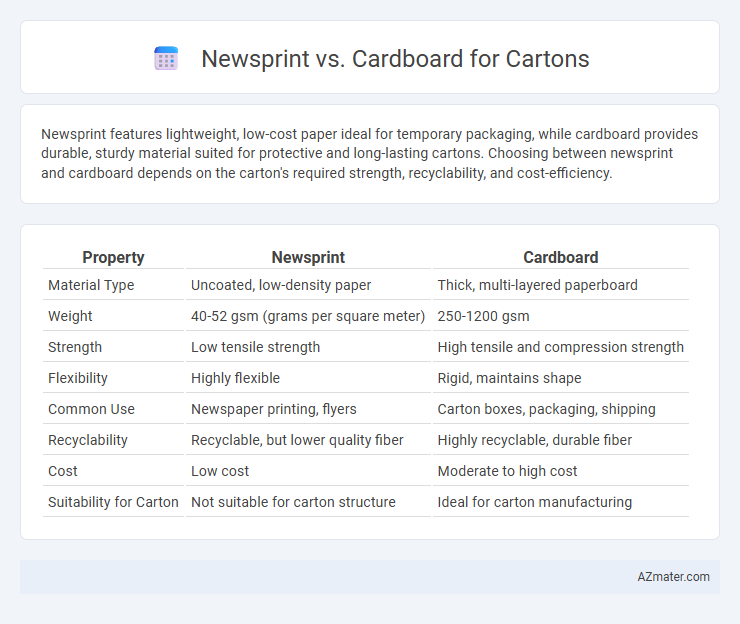Newsprint features lightweight, low-cost paper ideal for temporary packaging, while cardboard provides durable, sturdy material suited for protective and long-lasting cartons. Choosing between newsprint and cardboard depends on the carton's required strength, recyclability, and cost-efficiency.
Table of Comparison
| Property | Newsprint | Cardboard |
|---|---|---|
| Material Type | Uncoated, low-density paper | Thick, multi-layered paperboard |
| Weight | 40-52 gsm (grams per square meter) | 250-1200 gsm |
| Strength | Low tensile strength | High tensile and compression strength |
| Flexibility | Highly flexible | Rigid, maintains shape |
| Common Use | Newspaper printing, flyers | Carton boxes, packaging, shipping |
| Recyclability | Recyclable, but lower quality fiber | Highly recyclable, durable fiber |
| Cost | Low cost | Moderate to high cost |
| Suitability for Carton | Not suitable for carton structure | Ideal for carton manufacturing |
Introduction to Carton Materials
Newsprint, made from recycled wood pulp, offers a lightweight and cost-effective option for carton production, primarily used for lightweight packaging and limited durability needs. Cardboard, composed of multiple layers of thick paper or corrugated fiberboard, provides enhanced strength and rigidity suitable for protective packaging and heavier items. Choosing between newsprint and cardboard depends on the required strength, weight, and cost-effectiveness for specific carton applications.
Overview of Newsprint and Cardboard
Newsprint is a lightweight, low-cost paper primarily used for printing newspapers and packaging, known for its high porosity and recyclability. Cardboard, typically made from thicker paperboard or corrugated fiberboard, offers enhanced durability and structural strength, making it ideal for shipping cartons and protective packaging. Both materials are widely recycled, but cardboard's rigidity provides superior protection for heavier or fragile items compared to the flexible nature of newsprint.
Material Composition and Structure
Newsprint is made primarily from mechanically pulped wood fibers, offering a lightweight, low-cost option with a smooth surface ideal for printing. Cardboard, especially corrugated cardboard, consists of multiple layers of paperboard, including a fluted corrugating medium sandwiched between linerboards, providing enhanced strength and rigidity. The structural complexity of cardboard makes it more suitable for heavy-duty packaging compared to the thin, flexible nature of newsprint.
Strength and Durability Comparison
Newsprint offers lightweight and cost-effective printing surfaces but lacks the structural strength needed for heavy-duty carton applications. Cardboard, particularly corrugated types, provides superior durability and resistance to compression, making it ideal for packaging that requires protection during transit. The enhanced fiber bonding in cardboard ensures higher tensile strength and impact resistance compared to newsprint, supporting robust and long-lasting cartons.
Weight and Handling Differences
Newsprint is significantly lighter than cardboard, making it easier to handle and transport for cartons intended for lightweight packaging. Cardboard offers greater structural strength and durability, providing better protection for heavier products but often increasing shipping costs due to its higher weight. The choice between newsprint and cardboard depends on balancing weight considerations with the need for sturdiness in carton performance.
Cost Efficiency Analysis
Newsprint offers lower material costs compared to cardboard, making it a cost-effective option for short-term packaging needs. Cardboard provides superior durability and structural integrity, which reduces product damage and returns, thereby potentially lowering overall operational expenses. Evaluating the trade-off between initial material cost and long-term savings is essential for an accurate cost efficiency analysis in carton selection.
Printing and Customization Capabilities
Newsprint offers limited printing quality due to its porous surface, resulting in less vibrant colors and less detailed customization options for cartons. Cardboard provides superior printing capabilities with a smooth surface that supports high-resolution graphics, bold colors, and intricate designs, making it ideal for customized packaging. Enhanced printability on cardboard enables brands to implement complex branding elements, variable data printing, and finishes such as embossing or UV coating, which are not feasible on newsprint.
Environmental Impact and Recyclability
Newsprint offers a lower environmental footprint due to its lightweight composition and higher recyclability rate, typically exceeding 70%, which reduces landfill waste and conserves natural resources. Cardboard, while heavier and more resource-intensive to produce, provides greater durability and structural integrity for cartons but may have a slightly lower recycling efficiency, often around 60-70%, depending on contamination levels. Choosing newsprint over cardboard for carton production can result in a more sustainable packaging solution by minimizing energy consumption and enhancing circularity in the paper product lifecycle.
Best Use Cases for Newsprint Cartons
Newsprint cartons are ideal for lightweight packaging such as newspaper bundles, promotional materials, and disposable food containers due to their cost-effectiveness and recyclability. They offer excellent printability, making them suitable for high-visibility packaging where branding and design are crucial. Newsprint cartons are best used in short-term applications requiring easy disposal or recycling, minimizing environmental impact while maintaining adequate durability for handling and transport.
Best Use Cases for Cardboard Cartons
Cardboard cartons excel in packaging heavy or fragile items due to their superior strength and durability compared to newsprint, which is more suited for lightweight and temporary applications. Industries such as electronics, appliances, and food benefit from cardboard cartons as they provide enhanced protection and stacking stability during transportation and storage. The moisture resistance and print quality of cardboard also make it ideal for branding and long-term product display, unlike newsprint-based cartons that are more prone to damage and fading.

Infographic: Newsprint vs Cardboard for Carton
 azmater.com
azmater.com